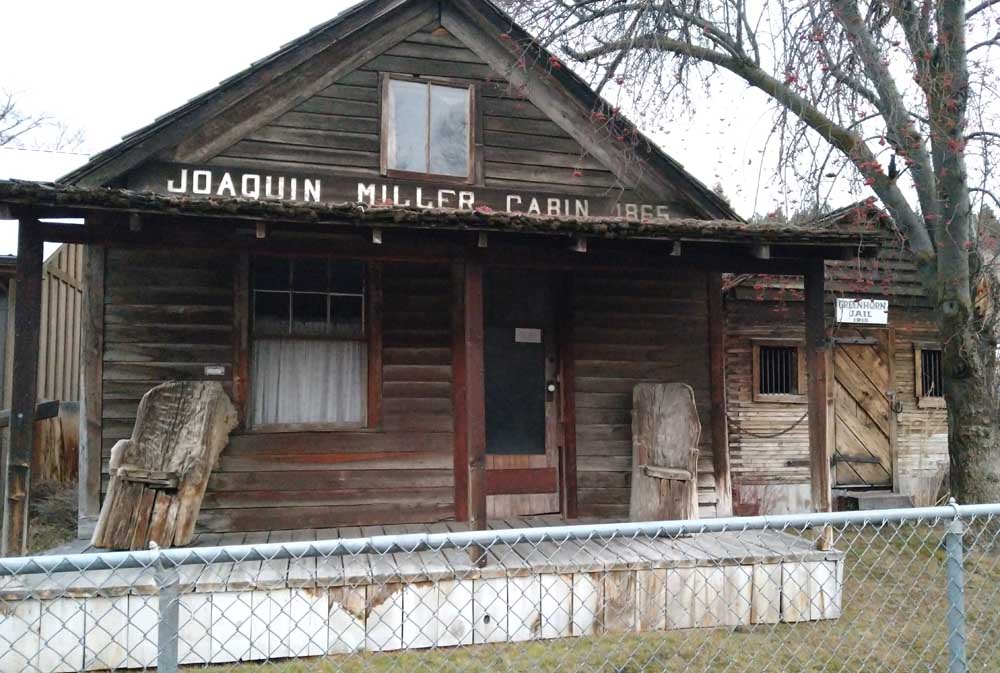Two historic buildings for one quick stop
Published 3:00 am Monday, March 14, 2022

- The historic Joaquin Miller Cabin and Greenhorn Jail are located along Highway 395 in Canyon City.
CANYON CITY — Those two old buildings next to the Grant County Historical Museum look pretty innocuous.
But, as the saying goes, if walls could talk, both would have some mighty tall stories to share.
The Joaquin Miller Cabin was the home of Cincinnatus Hiner “Joaquin” Miller, during his six-year stay in Canyon City in the mid-1800s. He, his wife, Theresa Dyer, and their children lived in the cabin on property not far from its current location.
Before, during and after his time in Grant County, Miller led a colorful life, traipsing from location to location, enjoying a string of adventures and pursuits. A sample includes cook, miner, poet, newspaper editor, rancher, teacher and lawyer. A full accounting of his exploits would fill many pages.
Born in the Midwest in 1839, Miller was 15 when his family moved to the Willamette Valley. Soon after, he set off on his own for a series of brief excursions. First, to the Yreka, California, area where he lived with Native American tribes; back to Eugene where he graduated from college and taught school for a year; then off to Idaho where he mined and was a Pony Express rider; and finally, back to Eugene where he launched a newspaper.
It was there in 1862 that Miller married Dyer, whom he met from her “Minnie Myrtle” poetry submissions to his newspaper.
In 1864, the Miller family settled in Canyon City, which was a lively, thriving community following the discovery of gold nearby just two years earlier. Miller built a cabin, set up shop as a lawyer and dabbled in poetry.
In 1866, at only 29 — and despite a reputation for underhanded behavior — he was elected to the position of Grant County judge.
A few years later, Miller and his wife divorced. And after his judicial term was over in 1870, he was on the move again. This time he headed to the San Francisco area of California, where he began devoting himself to writing poetry. Often called “The Poet of the Sierras,” Miller’s works include “Songs of the Sierras” (1871).
Miller’s travels also took him to Europe, where his poetry was well received, and Alaska, where he worked during the Klondike gold rush.
In 1886, he moved to Oakland, California, where he built a house and later died in 1913. That building is now a historical landmark, and the centerpiece of a 500-acre park. Both it and a cabin he built in Washington, D.C., bear his name.
Several locations throughout Oregon have also been named for this eccentric and legendary figure.
The Joaquin Miller cabin is furnished with Miller artifacts and other items typical to that time period, plus portraits of the couple and samples of his poetry.
Next door to the cabin, the Greenhorn Jail (circa 1910) is the subject of a shorter, but no less interesting tale.
During one night in 1963, the two-cell historic building was apparently “lifted” from its location in Greenhorn, about 45 miles northeast of Canyon City, by a group of unnamed locals. By morning, the jail was at its new home on the Grant County Historical Museum property — where it has remained for nearly 60 years.
The cabin, jail and museum are closed during the winter months, but are conveniently located on Highway 395 in the heart of Canyon City, making for an easy stop and photo op.






